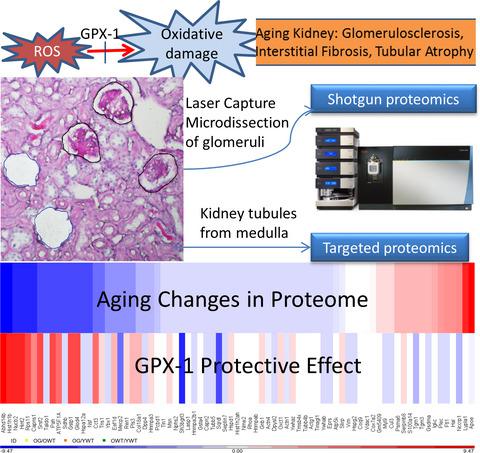当前位置:
X-MOL 学术
›
Aging Cell
›
论文详情
Our official English website, www.x-mol.net, welcomes your feedback! (Note: you will need to create a separate account there.)
Glutathione peroxidase-1 overexpression reduces oxidative stress, and improves pathology and proteome remodeling in the kidneys of old mice.
Aging Cell ( IF 7.8 ) Pub Date : 2020-05-13 , DOI: 10.1111/acel.13154 Yi Chu 1 , Renny S Lan 2 , Rui Huang 3 , Hao Feng 1 , Rahul Kumar 4 , Sanjana Dayal 4 , Kung-Sik Chan 3 , Dao-Fu Dai 1
Aging Cell ( IF 7.8 ) Pub Date : 2020-05-13 , DOI: 10.1111/acel.13154 Yi Chu 1 , Renny S Lan 2 , Rui Huang 3 , Hao Feng 1 , Rahul Kumar 4 , Sanjana Dayal 4 , Kung-Sik Chan 3 , Dao-Fu Dai 1
Affiliation

|
This study investigated the direct roles of hydrogen peroxide (H2O2) in kidney aging using transgenic mice overexpressing glutathione peroxidase‐1 (GPX1 TG). We demonstrated that kidneys in old mice recapitulated kidneys in elderly humans and were characterized by glomerulosclerosis, tubular atrophy, interstitial fibrosis, and loss of cortical mass. Scavenging H2O2 by GPX1 TG significantly reduced mitochondrial and total cellular reactive oxygen species (ROS) and mitigated oxidative damage, thus improving these pathologies. The potential mechanisms by which ROS are increased in the aged kidney include a decreased abundance of an anti‐aging hormone, Klotho, in kidney tissue, and decreased expression of nuclear respiratory factor 2 (Nrf2), a master regulator of the stress response. Decreased Klotho or Nrf2 was not improved in the kidneys of old GPX1 TG mice, even though mitochondrial morphology was better preserved. Using laser capture microdissection followed by label‐free shotgun proteomics analysis, we show that the glomerular proteome in old mice was characterized by decreased abundance of cytoskeletal proteins (critical for maintaining normal glomerular function) and heat shock proteins, leading to increased accumulation of apolipoprotein E and inflammatory molecules. Targeted proteomic analysis of kidney tubules from old mice showed decreased abundance of fatty acid oxidation enzymes and antioxidant proteins, as well as increased abundance of glycolytic enzymes and molecular chaperones. GPX1 TG partially attenuated the remodeling of glomerular and tubule proteomes in aged kidneys. In summary, mitochondria from GPX1 TG mice are protected and kidney aging is ameliorated via its antioxidant activities, independent and downstream of Nrf2 or Klotho signaling.
中文翻译:

谷胱甘肽过氧化物酶-1 过表达可减少氧化应激,并改善老年小鼠肾脏的病理和蛋白质组重构。
本研究使用过表达谷胱甘肽过氧化物酶-1 (GPX1 TG) 的转基因小鼠研究过氧化氢 (H 2 O 2 ) 在肾脏衰老中的直接作用。我们证明老年小鼠的肾脏重现了老年人的肾脏,其特征是肾小球硬化、肾小管萎缩、间质纤维化和皮质质量丢失。清除 H 2 O 2通过 GPX1 TG 显着减少线粒体和总细胞活性氧 (ROS) 并减轻氧化损伤,从而改善这些病理。衰老肾脏中 ROS 增加的潜在机制包括肾脏组织中抗衰老激素 Klotho 的丰度降低,以及核呼吸因子 2 (Nrf2)(应激反应的主要调节因子)的表达降低。尽管线粒体形态得到了更好的保留,但在老年 GPX1 TG 小鼠的肾脏中,Klotho 或 Nrf2 的减少并未得到改善。使用激光捕获显微切割,然后进行无标记鸟枪蛋白质组学分析,我们发现老年小鼠的肾小球蛋白质组的特征是细胞骨架蛋白(对维持正常肾小球功能至关重要)和热休克蛋白的丰度降低,导致载脂蛋白 E 和炎症分子的积累增加。对老年小鼠肾小管的靶向蛋白质组学分析表明,脂肪酸氧化酶和抗氧化蛋白的丰度降低,糖酵解酶和分子伴侣的丰度增加。GPX1 TG 部分减弱了老年肾脏中肾小球和肾小管蛋白质组的重构。总之,来自 GPX1 TG 小鼠的线粒体受到保护,肾脏衰老通过其抗氧化活性得到改善,独立于 Nrf2 或 Klotho 信号的下游。以及糖酵解酶和分子伴侣的丰度增加。GPX1 TG 部分减弱了老年肾脏中肾小球和肾小管蛋白质组的重构。总之,来自 GPX1 TG 小鼠的线粒体受到保护,肾脏衰老通过其抗氧化活性得到改善,独立于 Nrf2 或 Klotho 信号的下游。以及糖酵解酶和分子伴侣的丰度增加。GPX1 TG 部分减弱了老年肾脏中肾小球和肾小管蛋白质组的重构。总之,来自 GPX1 TG 小鼠的线粒体受到保护,肾脏衰老通过其抗氧化活性得到改善,独立于 Nrf2 或 Klotho 信号的下游。
更新日期:2020-05-13
中文翻译:

谷胱甘肽过氧化物酶-1 过表达可减少氧化应激,并改善老年小鼠肾脏的病理和蛋白质组重构。
本研究使用过表达谷胱甘肽过氧化物酶-1 (GPX1 TG) 的转基因小鼠研究过氧化氢 (H 2 O 2 ) 在肾脏衰老中的直接作用。我们证明老年小鼠的肾脏重现了老年人的肾脏,其特征是肾小球硬化、肾小管萎缩、间质纤维化和皮质质量丢失。清除 H 2 O 2通过 GPX1 TG 显着减少线粒体和总细胞活性氧 (ROS) 并减轻氧化损伤,从而改善这些病理。衰老肾脏中 ROS 增加的潜在机制包括肾脏组织中抗衰老激素 Klotho 的丰度降低,以及核呼吸因子 2 (Nrf2)(应激反应的主要调节因子)的表达降低。尽管线粒体形态得到了更好的保留,但在老年 GPX1 TG 小鼠的肾脏中,Klotho 或 Nrf2 的减少并未得到改善。使用激光捕获显微切割,然后进行无标记鸟枪蛋白质组学分析,我们发现老年小鼠的肾小球蛋白质组的特征是细胞骨架蛋白(对维持正常肾小球功能至关重要)和热休克蛋白的丰度降低,导致载脂蛋白 E 和炎症分子的积累增加。对老年小鼠肾小管的靶向蛋白质组学分析表明,脂肪酸氧化酶和抗氧化蛋白的丰度降低,糖酵解酶和分子伴侣的丰度增加。GPX1 TG 部分减弱了老年肾脏中肾小球和肾小管蛋白质组的重构。总之,来自 GPX1 TG 小鼠的线粒体受到保护,肾脏衰老通过其抗氧化活性得到改善,独立于 Nrf2 或 Klotho 信号的下游。以及糖酵解酶和分子伴侣的丰度增加。GPX1 TG 部分减弱了老年肾脏中肾小球和肾小管蛋白质组的重构。总之,来自 GPX1 TG 小鼠的线粒体受到保护,肾脏衰老通过其抗氧化活性得到改善,独立于 Nrf2 或 Klotho 信号的下游。以及糖酵解酶和分子伴侣的丰度增加。GPX1 TG 部分减弱了老年肾脏中肾小球和肾小管蛋白质组的重构。总之,来自 GPX1 TG 小鼠的线粒体受到保护,肾脏衰老通过其抗氧化活性得到改善,独立于 Nrf2 或 Klotho 信号的下游。


























 京公网安备 11010802027423号
京公网安备 11010802027423号